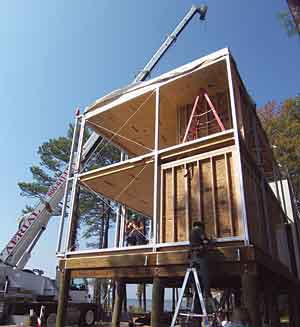Loblolly House: In Stock and Ready to Ship
Putting it together
For Bensonwood, the pinch points of the project occurred at the connections of the frame, elements, and systems. "There was no standard, nothing in the book you could use," Porchitz says. "That's really something missing in the construction industry as a whole." Each element, from the aluminum frame to a cartridge to a module, received a bar code (tracked within the Revit model) so that on-site assemblers knew exactly where to install them.
Aside from the aluminum frame connectors, the house uses an innovative system of electrical plug connectors that qualify under codes as junction boxes. This "quick-coupled" system allowed each cartridge's whip to plug into a main electrical channel that could then be plugged directly into the house's electrical panel, making field connections foolproof. Flexible radiant heating and domestic water tubing connects at a wall of manifolds in each mechanical room; heating is thermostat-controlled based on each room's environmental needs, but the manifolds also enable manual operation. The microducts, which Kieran says he included at his family's request, since the marshlands can get sticky hot in the dead of summer, also tie back to the mechanical rooms to small air-handling units.
 |
| Loblolly House, pictured above on October 4, was completed last month. Photography: © Russell Fortmeyer |
Although the house incorporates heating and cooling systems, the architects designed the entire west wall to open in various stages to the outside, in order to, as Kieran says, tune the house to shifting environmental conditions. A NanaWall system of glass doors provides environmental isolation, while an exterior-mounted, overlying aircraft-hangar-type door system acts as a separate bifold shading device, entirely electrically operated. The house's appearance-three closed sides and one entirely open-encourages Kieran to refer to Loblolly as a "duck blind," one of the ubiquitous hunting accommodations scattered across Taylor's Island.
The other comparison Kieran fondly makes is that of a barn raising, but few barns pack this technological punch. Unlike the garbage heap of unsuccessful prefab experiments of recent decades, which, in Kieran's words, failed to understand the need for predictable, standardized components and connections, the BIM model of Loblolly has proved effective in pulling a theoretical prototype together. "As soon as you get materials out in the field and they don't fit, you're into handwork, and then you might as well have done the whole thing by hand," Kieran muses. "That problem is gone."








